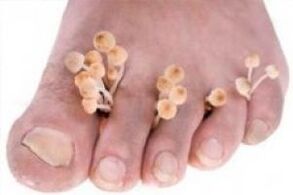Foot fungus can affect anyone with feet. Even the purest person is obsessed with hygiene procedures. Why does fungus appear on the feet and how to deal with this unpleasant nausea?
Why does fungus appear on the feet and how to deal with this unpleasant nausea?
How does foot fungus develop?
Even if a person washes his feet often, he cannot wash away all the bacteria on his feet. They will only become smaller, but they will not disappear completely. They multiply very, very fast, as long as a person steps on the floor, puts on slippers, or-more likely to breed bacteria-shoes, boots or sports shoes.
In a warm and humid environment, especially if your feet are sweating, the fungus just spreads. If such an environment coincides with the body's inflammatory process, poor resistance to infection, or excessive sweating in the legs-write it all down. The fungus is there.
Symptoms of fungus on feet
It affects the area between the toes, on the nails, and on the soles of the feet, and the top of the foot remains intact. If the fungus has entered the chronic stage, then the skin on the legs and other parts of the body is very dry and peeling, it has keratinized skin peeling off, and microcracks.
Along the border of the area where the fungus is located, red inflamed bands are clearly visible, and the skin behind is rough, dry and flaky.
If the fungus has not been treated for a long time, quite obvious cracks will appear on the skin behind the fungus area, which is very painful. If you add a bacterial infection, you will have severe leg pain, which makes you lie on a hospital bed because you can’t walk because of the pain.
Is the fungus transmitted from another person?
It is generally believed (and many people believe) that fungi can spread from person to person and can be infected. Indeed, if a person has been infected with the fungus, it will quickly spread to the entire foot area.
To prevent this process from becoming painful and depriving a person of the ability to walk, it is necessary to start treating the fungus in the initial stage of the disease.
Who to contact?
Dermatologist
How to treat acute fungus?
First, you need to put a sterile bandage on the foot, but not too tight. In pharmacies, antifungal infusions are sold-in the language of doctors, it is called an antifungal, or antifungal. With this infusion, you need to moisten the bandage and apply it to the affected area of the fungus.
This operation must be repeated each time the bandage is dry. When you see that the fungus does not cover the feet so densely, its performance begins to diminish, and you should not stop the anti-fungal wrap. Otherwise, the performance of the fungus will reappear. If there are cracks in the legs, you need to bandage the affected area to protect them from the penetration of pathogenic bacteria.
During the treatment process, it is very important that the feet are not exposed to high temperatures and water does not get on the feet-this will lead to a wider spread of the fungus. In addition, the surface of the feet should be dry and clean.
You also need to treat your feet, use vitamins, and take antifungal (antifungal) agents. At the same time, don't ignore the doctor's advice-he will advise how much money is needed for the treatment. If a person forgets to wipe his feet after washing his feet, he may get sick from the fungus-a humid environment promotes the rampant infection.
What can you wear with fungus on your feet?
For people suffering from tinea pedis, if they still have to go to work and the season is cold, it is worth hoarding a few pairs of stockings or tights (women), a few pairs of socks (men), and changing 3-4 times a day. This will prevent the infection from spreading further. What the patient wears on the feet must be natural materials, including shoes.
Shoes should not be tight, not narrow, and comfortable-this will make the feet feel comfortable, and the skin should not sweat frequently and breed bacteria and fungi.
drug
- Fungus spray.
- An ointment that is effective against fungi.
- Drops from nail fungus are a remedy for the local treatment of fungal diseases.
- Ointments and creams used to treat nail fungus.
- Nail fungus pills.
- Creams and ointments for foot fungus.
- Fungal ointment between fingers.















